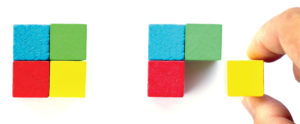
What Are Addition and Subtraction?
Addition involves increasing the number of objects in a set by joining objects. Subtraction involves decreasing the amount by separating a set into two or more smaller groups or taking some objects away from the initial set. Young children can solve simple addition and subtraction problems involving joining and separating small sets of objects and reasoning about the total after the operation.
Why Is Learning About Addition and Subtraction Important?
Addition and subtraction with small sets prepare children to later add and subtract larger quantities and to learn about other math topics, including multiplication and division. Multiplication can be thought of as repeated addition and division can be thought of as repeated subtraction.
What Do Children Need to Know About Addition and Subtraction?
- Adding means putting numbers or sets of objects together and getting more (unless you are adding zero).
- You can use counting to see how many there are all together.
- You can add in any order.
- Subtracting means taking away so you end up with less (unless you are taking away zero).
- After some objects have been taken away, you can count what’s left over to get the answer.
- Children can understand addition and subtraction without learning addition or subtraction facts, and without learning the plus (+) or minus (-) signs.